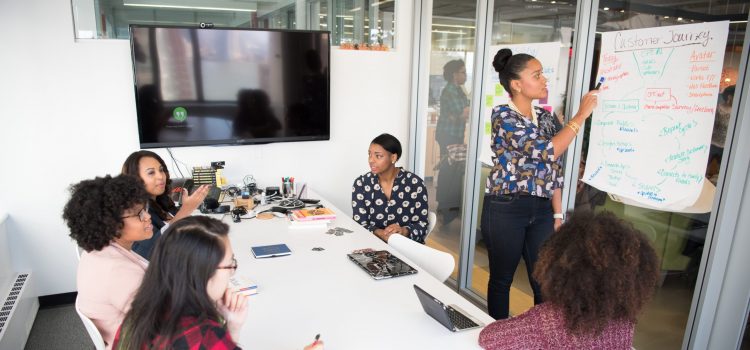

This article is an excerpt from the Shortform book guide to "Leadership Is Language" by L. David Marquet. Shortform has the world's best summaries and analyses of books you should be reading.
Like this article? Sign up for a free trial here.
Are your employees failing to work as a team? How should you encourage participation to get the job done?
While working on a team project, your first collaboration session with your team involves weighing your options and deciding upon a course of action. Leadership Is Language by L. David Marquet suggests a few ways to communicate open participation during these sessions.
Discover how to encourage participation and invite honesty in the workplace.
Normalize Pause Points and Manage Time Proactively
People tend to get stuck in execution mode because it takes less effort to plow on with a task mindlessly. To learn how to encourage participation and prevent your team from getting stuck in execution mode, introduce the concept of pause points when you meet for collaboration. Make it easier for your team to call a pause point by deciding on a name for them (like a “mindful moment”) or schedule them in advance. This creates more opportunities to adjust your course of action and make new decisions rather than getting stuck with the first decision you and your team made.
To lower the barrier for calling timeouts, Marquet suggests using language that conveys vulnerability instead of certainty, such as, “I’m not sure if this is the best approach given that a couple of team members are absent today. Let’s see what we learn and revisit this decision in four hours.” This allows team members to feel comfortable calling pause points and expressing concerns while they work.
(Shortform note: When taking Marquet’s advice, you might worry that vulnerable language makes you seem weak or unconfident. In Dare to Lead, Brené Brown argues that the opposite is the case: Vulnerability requires openly acknowledging risks and confronting your fears head-on rather than ignoring them completely, which is something that takes courage. She makes a distinction, however, between being vulnerable and oversharing to manipulate other people’s emotions. For example, if you share how you haven’t slept or eaten for three days because of a pressing issue your team is dealing with, you’ll only make everyone feel more anxious. Instead, Brown suggests you simply focus on opening a safe space to discuss a situation honestly.)
Invite Comfortable and Honest Participation
Once you’ve introduced and encouraged your team to call for pause points if needed, collaborate on brainstorming your options. To do so, ensure that everyone feels comfortable enough to participate. Accomplish this by asking open-ended questions, voting on options before discussing them, and encouraging dissent.
Open-ended questions: Marquet suggests using “how” and “what” questions to avoid implying that one option is better than another. For example, you could ask, “How strongly do you feel about Option A and Option B?”
(Shortform note: Other experts say you should also ask open-ended questions in areas outside of decision-making—for instance, when having difficult conversations. In the same way workers might hesitate to share their thoughts, people also feel insecure when having uncomfortable conversations. The authors of Difficult Conversations argue that open-ended questions help make others feel heard and allow you to get more information about what they’re feeling or thinking. Rather than framing conversations around your opinions and beliefs, open-ended questions allow you to focus on understanding theirs.)
Vote first: Before anyone shares their thoughts on which option seems best, encourage honesty by having everyone vote on the options first. This prevents biases that commonly affect people’s opinions, such as giving more weight to the first option they hear. Marquet suggests using methods like probability cards or a fist-to-five voting method. Probability cards involve each member voting with a card with numbers like 1 or 80 or 99, where 1 indicates strong disagreement and 99 indicates strong agreement. The fist-to-five method involves showing agreement using their fingers, with a closed fist meaning strong disagreement and five fingers meaning strong agreement.
(Shortform note: There are other ways to prevent biases from getting in the way of good decision-making. Before you meet to vote on the options, you might consider having team members write down their ideas on their own beforehand. This can prevent production blocking, or the idea loss that happens during group discussions. When listening to one person talk, people tend to forget their own ideas or tune out the person who’s speaking because they’re forming their own ideas. By having their ideas written down, team members can actively listen to and vote on other people’s ideas without the fear of forgetting their own.)
Encourage dissent: Remind your team that to generate better solutions, they should be curious and open to different ideas and perspectives. Get your team comfortable with dissent, for instance, by having members play devil’s advocate. Marquet also recommends encouraging dissent over consensus when contemplating the best course of action. This is because people tend to try to agree with one another, which can cause you and your team to lose valuable insights and innovative ideas.
(Shortform note: In Originals, Adam Grant agrees that dissent should be welcomed but argues that assigning a devil’s advocate is less effective than finding people who truly have dissenting views. He suggests you appoint an information manager to talk with people before your meeting and discover their true viewpoints. During your meeting, you can also ensure that team members can voice both popular and unpopular opinions by having your team rank the options in order of preference. When groups debate options one at a time, they tend to agree on one option too quickly. By ranking them instead of simply discussing each, your team must consider all possible options, which gives people who have minority opinions the opportunity to voice them.)
Decide on a Hypothesis to Test
Once you’ve brainstormed ideas, your team must decide on a course of action to take. Marquet suggests you treat your decision like a hypothesis—an assumption to test—rather than as something that’s fixed and unable to be changed. This mindset is more flexible and allows you to pivot to new directions if needed.
(Shortform note: Treating your decision like a hypothesis may help your team be less fearful of taking risks and overcome feelings of shame if your decision goes badly. When we make decisions, we’re often afraid of making wrong choices because being wrong damages our self-worth and causes us to feel shame. Often, this shame becomes worse when we view decisions as final. Approaching your decisions like they’re experiments, experts argue, removes this notion of finality and replaces it with curiosity: You merely observe what might happen and know that you can make changes and try again.)
When selecting a hypothesis, Marquet writes that the final decision should be made by someone other than the person who proposed the idea. People tend to become emotionally invested in their own suggestions and often favor their ideas over others’ ideas. To avoid this, Marquet suggests that team members decide on the hypothesis to test while the leader has the final say to approve or reject it.
(Shortform note: Some research shows that leaders and groups tend to be overconfident about the ideas they propose than the average lone employee. Leaders feel more confident about ideas because of their higher status, while groups feel more confident because they share strong ties and feel in sync with one another. The average lone employee, on the other hand, tends to be more realistic about their ideas. Therefore, to avoid bias, it might make more sense to leave the responsibility for making the final decision in the ideator’s hands, rather than in the hands of an overconfident leader or group. You might do this by having them reconsider their ideas after taking a break or moving to a new location.)

———End of Preview———
Like what you just read? Read the rest of the world's best book summary and analysis of L. David Marquet's "Leadership Is Language" at Shortform.
Here's what you'll find in our full Leadership Is Language summary:
- Why most leadership language discourages workers from speaking up
- A new approach to leadership that empowers workers to participate
- How to create an adaptive, innovative, and high-performing workplace






